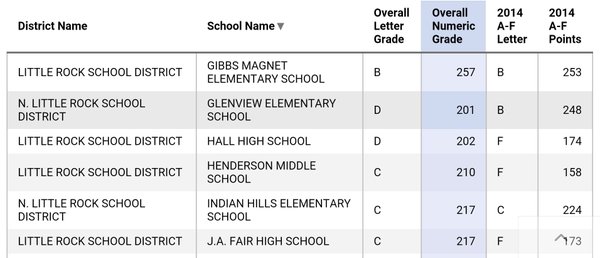The number of Arkansas public schools earning A and B grades on newly posted, online state report cards dropped by half, from 484 schools in 2014 to 234 in 2015.
The A grades, in particular, are rare. Only 10 schools -- in places as big as Little Rock and Hot Springs and as small as Bismarck and Marshall -- earned A's for the 2014-15 school year, compared with 162 A-graded schools for 2013-14, the first year for the A-F letter grades.
[SEARCH: Click here for a searchable database of all school grades]
State education leaders last week attributed the decline in A's and B's and the accompanying jump in C-graded schools -- from 365 to 564 -- to a change in the state's student testing program between 2014 and 2015. Schoolwide achievement and achievement gains on the tests as well as graduation rates, where applicable, are the basis for the letter grades that are required by Act 696 of 2013.
"During the 2014-15 school year, students took more rigorous tests aligned with more rigorous standards," Annette Barnes, the Department of Education's assistant commissioner for public school accountability, said Friday.
Last year, the state moved away from the long-used Arkansas Benchmark and End-of-Course exams, and required school systems to give the all-new Partnership for Assessment of Readiness for College and Careers (PARCC) exams in math and English/language arts.
The more academically challenging PARCC tests are based on the Common Core State Standards in math and English/language arts that Arkansas and more than 40 other states adopted in 2010 and phased in over three years. Unlike the previous Arkansas paper-and-pencil tests, the PARCC tests were given online in most schools and were divided between two testing periods: problem-based assessments given in March and end-of-year tests given in May.
In Arkansas, only about 1 in 3 test-takers scored at the desired Levels 4 and 5 on the English/language arts sections of the PARCC tests last spring. In math, about 1 in 4 Arkansas students scored at desired levels. Students who scored at Level 4 met standards for the subject and grade level. Those scoring at Level 5 exceeded expectations for achievement.
Those test results are reflected in the letter grades for schools.
In all, 54 percent of 1,045 Arkansas schools earned C's for the 2014-15 school year.
A total of 228 earned D's, up from 160 the previous year. But the total number of schools getting F's -- 19 -- is down by more than half for 2015 when compared with the 43 schools getting F's based on testing in 2014.
The 19 schools getting F's are: Blytheville Middle School; Matthews Elementary, Morehead Middle and Townsend Park Elementary in Dollarway School District; Retta Brown Elementary in El Dorado School District; Hartford Elementary in Hartford School District; William Jefferson Clinton Primary in Hope School District; Little Rock Prep Academy Elementary charter school; Boone Park and Park Hill elementaries in North Little Rock School District; Pine Bluff Lighthouse Academy charter school; Oak Park Elementary in Pine Bluff School District; Harris and Pinewood elementaries in the Pulaski County Special School District; Quest Middle School of Pine Bluff charter school; Jackson and Wonder elementaries in West Memphis School District; Eastside New Vision Charter School in Warren School District; and Westside Elementary School in the Westside School District in Johnson County.
There are no rewards or penalties tied to the A-F letter grades, which are found on the top left-hand corner of each school's 15-page online report card. The cards are found under the "Data" link on the Arkansas Department of Education website: arkansased.gov.
Additional, more specific information about the letter grades for schools -- including a detailed description of the calculations -- can be found by clicking on the "Parents" link at the top of the state agency Web page. The formula for calculating the grades was developed by the Office for Innovation in Education at the University of Arkansas at Fayetteville in consultation with representatives of the Arkansas Education Department different education-related organizations.
"As a tool, the letter grades help parents, schools, districts and communities make informed decisions about education," Barnes said Friday through Education Department spokesman Kimberly Friedman.
"Parents should become aware of how well schools are performing in the community and talk with school educators about what the grades mean," Barnes said. "They should talk with teachers and school officials about how to help the school, volunteer at school and engage in areas that need improvement; and ensure children have excellent attendance, that they complete all their assignments and they are engaged in learning."
Barnes also said that while letter grades are good indicators of how well individual schools are performing, "they do not take into consideration other things the school may be doing well, such as meeting students' nutrition and health needs or how well students are performing in other subject areas."
The school rating system is based on a grading scale of 1 to 300. Haas Hall Academy, an open-enrollment charter school for eighth- through 12th-graders in Fayetteville, actually had 310 points, 10 points above the maximum.
Other A schools are Benton High, Bismarck High, Cave City High, Concord High, Skyline Heights Elementary in Harrison School District, Park Magnet School in Hot Springs, Forest Park Elementary in Little Rock, Salem Elementary in the Salem School District, and Marshall High in the Searcy County School District.
Forest Park Elementary with 285 points was the second-highest scoring school in the state and the only A-graded campus among Pulaski County's traditional and open-enrollment charter schools. Forest Park earned an A the previous year as well.
"I'm very thankful and appreciative of the work ethic that our faculty and staff put forth every day, along with the support that our parents provide us in myriad ways," longtime Forest Park Principal Theresa Ketcher said Friday.
Ketcher also said she was "relieved" by the grade.
"As principal it starts with me," she said. "We always try to do as much as we can .... we are reading the book The Motivated Brain, and last year we read The Mindset. We are always trying to reach out there and capture what it is that will engage children in learning. We can no longer just stand there and give the information. [The children] have to engage in the experience of doing it or collaborating and talking about it, or researching about it -- even the littlest ones. How these children learn is changing because they have technology skills. They have that savvy. They get bored quickly if you are not on your A game."
The grades earned in the Little Rock district, which is under state control because six of its schools are classified by the state as academically distressed, include one A, nine B's, 15 C's, 17 D's and no F's. The previous year the state's largest district had seven schools getting F's and four schools earning A's.
In the Pulaski County Special School District, no schools earned A's although two did so in 2014. Two schools earned B's as compared with four in 2014. There were 15 C's, 16 D's and two F's, which was down from the previous year's 3 F's.
In the North Little Rock School District, there were four C's, eight D's and two F's.
The competitive juices were at work at Bismarck High School, which missed an A grade by 6 points the first year grades were given.
Larry Newsome, a former coach and principal for seven years at the Hot Spring County school, said he and his staff made turning that B into an A a schoolwide goal.
Bismarck began in the 2014-15 school year to give the NWEA Measure of Academic Progress tests to students throughout the school year.
"We were able to break the [test result] data down and hit those low areas that students were struggling in -- the skills that the students were lacking," Newsome said. "The difference for us was we had time to get my leadership group together and begin to look at the data, really analyze it, to see the skills our students were low in. Our teachers went back and reviewed those skills to make sure that we were giving students what they needed to meet the standards."
The staff also worked together to design and update curriculum units for teaching math and literacy, taking into account what the testing data show, Newsome said.
"We have a really good staff here. Our teachers do a great job for us, really work hard. And we have good kids," he said of the 316 students in grades nine through 12.
The high school is on the state list to receive reward money for achievement through a different state program not directly connected to the school grade.
He said the staff will receive a bonus as a result of those funds.
"Of course, we are going to do some things for our kids, too," he said.
The original formula for grading schools had to be revised for the newly released 2015 report cards to take into account the change to the PARCC testing program.
The multipart calculation includes a weighted performance score based on student achievement on the PARCC exams last spring and a growth score. Graduation rates and other factors also can be included in the calculation when applicable. And, for the first time, schools could receive up to 6 challenge points for better-than-expected achievement.
The weighted performance score in the formula is determined by giving points for the students' level of performance on the PARCC exam last spring.
Schools received zero points for each student's test that earned a Level 1 score, which is the lowest performance level on the PARCC test. Partial points were given for each Level 2 and 3 score. One point was given for each Level 4 and Level 5 score. A Level 4 score indicates that a student met grade-level expectations on the test. A Level 5 score indicates a student exceeded expectations.
If there are more Level 5 scores at a school than Level 1 scores, bonus credit is awarded. The school receives 1.25 points for each Level 5 score above the total number of its Level 1 scores.
All of the points earned at a school are added together. That is divided by the total number of tests given. And that result is multiplied by 100. The result is the school's weighted performance score.
The school's growth score -- another component of the letter grade calculation -- involves a "value-added measure" that compares how a student performed on the test with how he was predicted to perform based on achievement in previous years.
A student's predicted score in 2015 is subtracted from his actual score for 2015 to generate the value-added score. The value-added scores for all students at a school are averaged to produce the school's growth score.
Sarah McKenzie, executive director of the University of Arkansas' Office for Education Policy, was complimentary Friday of the revised letter grade system.
"First of all, if everybody gets an A, then the grades have no meaning," McKenzie said. "I like it that there is a nice distribution from A through F. That gives us some room to continue to improve and get realistic about where we are. I like that they are using the value-added model for the growth. I think it is a huge improvement. What I like about it is that it answers the question 'How did schools do with kids based on what we thought they were going to do?'
"That is at the heart of a great school. Even for the kids who come in scoring at proficient, did you grow them? For those kids who came in scoring below proficient, they may not make it to proficiency, but did you grow them while they were with you? I like that the letter grade includes that," she said.
The Office for Education Policy's website -- officeforeducationpolicy.org -- includes a spreadsheet that splits out the letter grades into a school score for performance and a school score for growth.
The formula for grading schools will change again once student testing is completed this spring. Arkansas has switched from the PARCC exams to the ACT Aspire exams for grades three through 10.
SundayMonday on 04/17/2016



